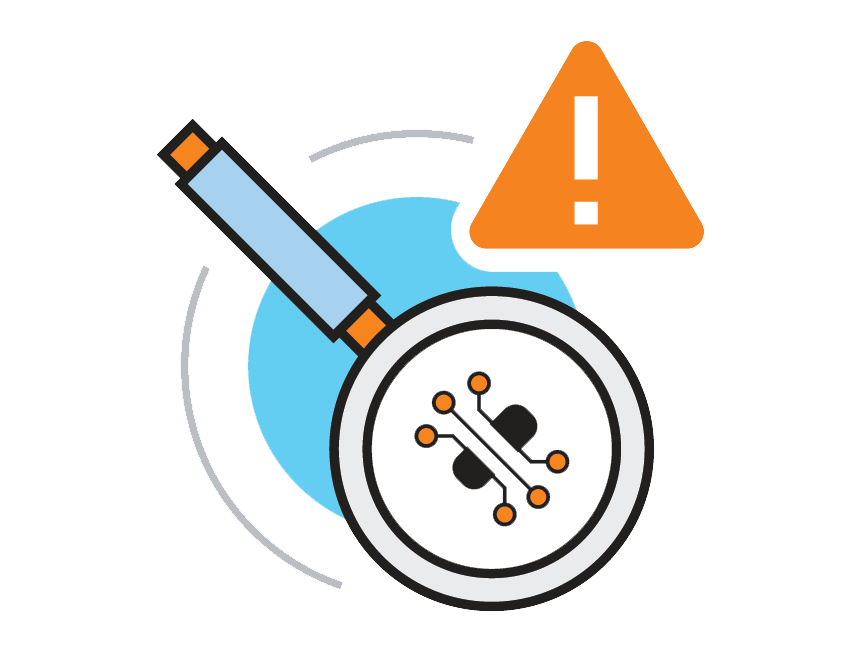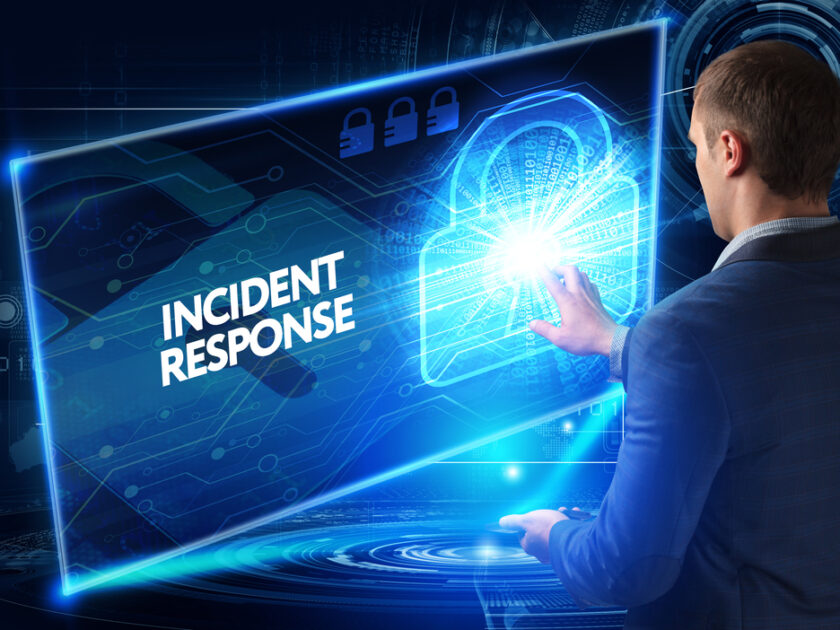Cybersecurity Incident Response & Recovery Services
Integrate sophisticated intelligence, threat detection, incident response, and recovery services for continuity and transformation that is uninterrupted. Develop an insightful Incident Response Plan in the case of a sophisticated security breach or cyber assault.

Advanced IT and Data Security, Risk Management for Peak, Protected Performance
As organizations’ dependence on the digital world grows, so do the assaults or threat situations that result in data breaches or loss, interrupted company operations, and information security risks. Potential risk-reduction panaceas include a solid architectural system design, standard controls, and frequent vulnerability testing and security assessments. However, the current architecture for information security cannot ensure the absence of invasions and other hostile activities. When security events occur, it is essential for companies to recognize and respond to the occurrence.
A method for responding to incidents or incident response planning allows firms to reduce losses, patch exploitable vulnerabilities, and restore impacted processes and systems. The process includes laying the foundation for known and unknown cyber risks, determining the fundamental causes of security breaches, and developing a disaster recovery strategy post-event or post-cyber assault.
Your World-Class Incident Response Team for Cyber Incident Management with CDWT
Cybersecurity problems, such as data breaches, are pervasive and advancing. Organizations must have methods for identifying, assessing, and reacting to security events that jeopardies the confidentiality, availability, and integrity of vital data and systems. An efficient incident response and recovery software monitors host and network logs, implements security devices, collects evidence from compromised systems for analysis, and makes recommendations against malicious or inadvertent activities that might destroy systems or data.
CDWT offers both proactive security monitoring and threat intelligence for vulnerability management and incident response pertaining to software, service, and industry security. CDWT Maintained Services leverage cutting-edge automations to provide a 360-degree picture of the security posture of systems, services, and IT infrastructure. These services are designed and managed by renowned security specialists. Create an Incident Response Plan to remove possible cyber risks and speed the recovery of enterprises until regular operations are restored in order to strengthen business continuity and future-proof growth. Utilize CDWT to bolster your incident response teams and protection measures for sensitive data and network security situations.
Principal Advantages of Incident Response Strategy
Comprehensive Safety Without Complicatedness
- Utilize the industry's most comprehensive array of threat management solutions.
- Obtain vendor-agnostic support for endpoint and network security solutions while eliminating vendor lock-in.
Boost Productivity and Rapid Reaction
- Combine organic threat intelligence and AI-powered automation with threat intelligence and incident response technologies to increase SOC efficiency.
- Reduce the dwell period of serious cyberattacks and react to threats 24x7 with promptness.
Prevent Future Incidents
- Identify threats more consistently than static indications of compromise (IOC) using the TTP threat hunt library and the MITRE ATT&CK methodology for proactive threat detection.
Verified, well-documented incident response plan
- Having sound incident response protocols in place in order to avoid functioning in crisis mode.
- With well-planned incident response and threat intelligence services, you may identify possible dangers before they occur and take preventative action.
Rapid Reaction During a Data Breach
- Even if a good incident response strategy is in place, an attack must be investigated and stopped immediately.
- Utilize incident responders, forensic investigation, malware analysis, and threat assessments, among other tools, to evaluate the issue and mitigate the harm.
Post-Incident Monitoring
- Enable your company to monitor impacted systems and incorporate/document how they should react to the next attack or breach for proactive recovery.
Strengthen Incident Readiness
- With the assistance of security specialists, enhance incident response preparation while minimising the effect of data breaches on core processes. Enhance and improve your incident response strategy.
Utilize Automation to Strengthen Cyber Resilience
- Hyperscale automation empowers your security team with strategic goals, streamlines repetitive operations, and enables rapid incident response times.
Lifecycle Mapping of Incident Response and Recovery
Here are essential actions an incident response team must take to prepare for cyberattacks:
- Threat Preparation Stage
- Phase of Threat Identification
- Phase of Threat Containment
- Phase of Threat Eradication
- Threat Mitigation and Asset Restoration
- Comprehensive Evaluation
- Develop an internal incident response team and processes, as well as an effective incident response strategy, for use during a cyberattack.
- Review security protocols and conduct risk assessments for external attacks, internal abuse/insider threats, and situations in which external reports of possible security vulnerabilities and exploits are received.
- Prioritize known security flaws or vulnerabilities that cannot be resolved promptly. Concentrate on big security events affecting critical infrastructure and data, and be mindful of your most valuable assets.
- Create a communication plan for internal, external, and data breach reporting.
- It is vital to choose, train, and provide team members with access to the required systems, technologies, and resources.
- Inform the members of the organization's larger network on how to report suspicious security occurrences or information.
Select the conditions that will activate the incident response team. Monitoring tools, log files, error messages, firewalls, and intrusion detection systems are the sources from which IT systems gather events. This data should be analysed by automated technologies and security professionals to evaluate if anomalous occurrences represent security incidents. For instance, they must examine multiple aspects, changes in behaviour, and new events to determine whether someone is attempting to do damage to a web server. When an incidence is contained, the incident response team must be notified. The team must organize the most appropriate reaction to the incident:
- Determine and assess the event while gathering evidence
- Determine the nature and severity of the event and, if necessary, escalate the issue.
- Describe the actions you took, focusing on the "who, what, where, why, and how." If the incident reaches a court of law, this information might be presented as evidence.
After isolating a security incident, the objective is to prevent further harm. It encompasses:
- Short-term containment requires a timely reaction to prevent the danger from causing more damage. This may include isolating a vulnerable network section or putting hacked production systems down.
- Before wiping and restarting any affected systems in order to acquire a "present state" or forensic image, you should back up all of them. A forensic image is an identical reproduction of a hard disc or a specific partition on a disc. Following a security event, disc images are created to preserve the state of a disc and provide a static "snapshot" of how the system was compromised.
- Long-term containment: Rebuild clean systems to bring them online throughout the recovery phase, while implementing interim solutions to replace systems that were taken down to image and restore. Install security fixes on impacted and connected systems, erase accounts and backdoors established by attackers, tweak firewall rules, modify routes to null route the attacker IP, and take additional preventative actions to avoid a recurrence or worsening of the issue.
Protect against the danger and restore the fundamental systems to their original condition. To avoid future attacks, the team must identify the attack's main source, eliminate threats and malware, and identify and patch any exploited vulnerabilities. These actions may alter the organisational structure. The objective is to execute changes with little effect on the organization's day-to-day operations by restricting and minimising the quantity of exposed data. Ensure that your team has inspected the affected systems for harmful information and removed it. For instance, if attackers exploited a particular vulnerability, it must be resolved.
- Determine and address any external or internal impacted hosts
- Eliminate all software instances by concentrating on the attack's origins
- Examine malware to determine the extent of any harm.
- Observe if the attacker has reacted to your actions- verify newly created credentials or permission escalations responding back to the proclamation of any public exploits or POCs
- Ensure there are no secondary infections, and if there are, eliminate them.
- Protect the network and guarantee that the attackers do not conduct any additional attacks.
Priority is placed on reintroducing impacted systems to the production environment at this step so that they do not cause another incident. Always restore systems from clean backups, replace damaged files or containers with clean ones, reinstall systems from scratch, apply patches, change passwords, and strengthen network perimeter security using boundary router access control lists, firewall rulesets, and other measures.
Determine how to verify that the affected systems are running properly, as well as how long you must monitor the affected network and endpoint systems. Determine the cost of the data breach and any related implications, such as lost productivity and the amount of time required to debug, restore, and recover completely.
After each event, it is beneficial to hold a debriefing or lesson-learned meeting to memorialise what occurred, what went well, and the opportunities for improvement. To improve future processes, the incident response team should interact with relevant parties. Finish the paper that was not produced throughout the response procedure. The team must describe how the event was addressed and eradicated.
Analyze the procedures utilised to restore the damaged system and the areas where the response team may be improved. Examine if the incident response strategy was effective and identify any holes. The event is thoroughly analysed in reports on lessons learned, which may be employed in meetings, as comparison points, or as training material for new members of incident response teams.



INCIDENT MANAGEMENT
CDWT End-to-End Incident and Threat Management Services: Maintain vigilance in the face of next-generation threats and vulnerabilities
- Threat Monitoring
- Ingestion of Data and Telemetry
- Intelligent Threat Hunting, Research, and Detection
- In-Depth Incident Analysis
- Security Response Automation and Threat Mitigation
- Security at the endpoint with managed endpoint detection and response (EDR)
Obtain deep threat monitoring of the IT stacks, including people, devices, apps, networks, servers, data and datacenter assets, cloud platforms, and endpoint environments, 24 hours per day, seven days each week.
Gain automatic alert management and optimization (to decrease alert fatigue), as well as insight into the risk posture of the whole company.
Integrate MDR suite with mission-critical, high-fidelity internal and external dataflows from all IT landscape segments.
MDR facilitates data intake and monitoring from internal networks and IT infrastructure, devices, platforms, and external landscapes, cloud platforms, remote IT architectures, and third-party service providers.
Integrates threat information for threat research, discovery, and hunting, while identifying risks lying behind the most basic perimeter layers or concealed from ordinary rule-based assessments.
Using Advanced Threat Protection, analyse benign code to detect new dangers and assure preventative maintenance. Prepare for improved managed detection, endpoint detection, and incident response for similar or other situations.
Using advanced security analytics, automatically classify threats, risky use cases, and threat monitoring and hunting into appropriate event categories. Helps create an advanced incident response strategy.
Categorize warnings, prevent alert fatigue, and support the Security Response Team in gaining sophisticated, real-time threat intelligence to make educated decisions.
Intelligent automation solutions may reduce Mean Time to Detect and Mean Time to Repair for end-to-end IT assets.
Automatically halt the harmful software's operation and undertake a thorough examination of its repair.
Aviall a collaborative threat mitigation action mechanism between the CSIRT/SOC of the supplier and the security team of the customer.
Integrate next-generation antiviral capabilities with additional cognitive tools for real-time anomaly detection and alerting, forensic investigation, and endpoint cleanup.
Track the execution and modification of files, changes to the registry, network connections, and binary execution across your endpoints.
- Advanced Security Operation Center (SOC) Management Services
- Cybersecurity Evaluation
- Compliance and Security-as-a-Service
- Solution for Intelligence on Danger
- Monitoring and Protection of the Dark Web
Cybersecurity Incident and Response Team (CSIRT) of CDWT provides threat monitoring and management and aids in the adoption of innovative cybersecurity frameworks, incident response plans, and intelligent solutions.
Receive assistance from world-class security experts with IAM, SEM, ATP, Root Cause Analysis, Compliance Audits, and Advanced Penetration Testing services.
Provide strategic advice to better monitor and manage on-premises or cloud-based organisational security.
Obtain continuous monitoring of assets, resources, access control review, and compliance audits for enhanced data protection, as well as advice services for misconfigured networking-server assets.
Compliant-ready services provided by CDWT guarantee that client facilities comply with data localization-residency laws, national regulations, local compliances, secure identity compliance, and international certifications.
Adopt cloud-native solutions for complete compliance monitoring and management, hardware-based key storage for regulatory compliance, and governance-auditing-risk reduction.
Sophisticated security intelligence solutions from CDWT include advanced threat hunting, data forensics, anomaly detection, and automated response management.
Adopt AI-powered cybersecurity for end-to-end asset management and monitoring, including last-mile connectivity and end device security.
Utilize the Self-Healing or Preventive Maintenance Platform to consolidate cybersecurity management for IP/Domain Reputation, File Reputation, and IT assets (SHOP).
With CDWT Dark Web Monitoring and Protection, you can monitor corporate data and get fast warnings of any online dangers. Take urgent action and enhance the security of your business.
Dark Web Scan does a search for stolen usernames, passwords, social security numbers, and credit card data available for sale.
Dark Web Monitoring aids in the monitoring of large-scale operations and establishes a safety net. Dark Web Protection detects identity theft, protects data loss, and analyses malware.
CDWT Incident Management Advantages
Why Should Your Enterprise Partner with CDWT for Cybersecurity Transformation?
The world's biggest Application-focused Managed Cloud Services Provider and a leader in managed cybersecurity. Dedicated security evaluation services.
12+ years of service to 4000+ corporations, including 60+ Fortune 500 companies, in 25+ countries spanning the Americas, Europe, Middle East, and APAC.
More than 40 Security Controls, twenty Centres of Excellence, and two thousand worldwide cloud specialists
Pre-met compliance demands for local, national, and international compliance regulations, such as IRAP, GDPR, HIPAA, SAMA, CSA, GXP, and ISO Certifications.
3200 UTMs, 13000 HBSS, 800000 EPS
Seven Security frameworks using the MITRE ATT&CK, CIS Critical Security Controls, and more
Comprehensive 24x7 monitoring of cyber security
Advanced Managed Detection and Response Solutions Automated Security Solutions for threat prediction, detection, and response (MDR)
Expertise in managed SOC (Security Operations Center) services and solutions on a global scale.
DevSecOps-specific portfolio
Cybersecurity Consulting, Cybersecurity Assessment, and Audit Reporting Services for the Entire IT Stack and Cloud Infrastructure.
Advanced Cybersecurity Incident and Response Team (CSIRT) for CDWT
Threat Intelligence powered by Industry-leading platforms such as Microsoft, OSINT, STIX&TAXI, MISP, etc. and CDWT Threat experts
Considerable threat management knowledge in protecting big and complex settings and using the sophisticated features of industry-leading technologies and Cloud-Native Security products.
Expertise in building and administering comprehensive SIEM - assisting organisations in proactively assessing vulnerabilities and automating and accelerating incident response.
Cybersecurity Incident Response and Recovery – FAQ’s
Data corruption occurs when data is lost by mistake or on purpose.
System hijacking/Ransomware: Intruders control systems from their own end or sell access to other criminals in order to abuse data.
Encrypt the data and demand a ransom to decrypt it.
DDoS: Attackers flood a website with malicious requests and interrupt regular traffic flow.
SQL injection: Attackers install databases without enough security and improperly modify the database.
Investigations, audits, or reviews undertaken by security professionals, such as a threat hunting procedure to check for intrusions, are additional methods for detecting security breaches.




